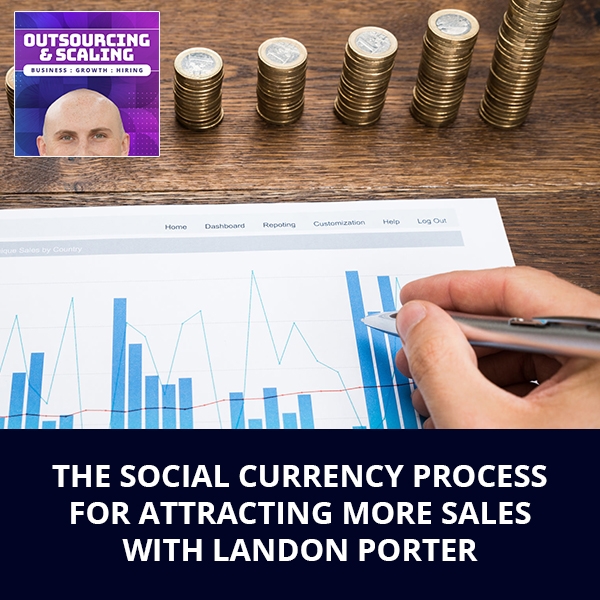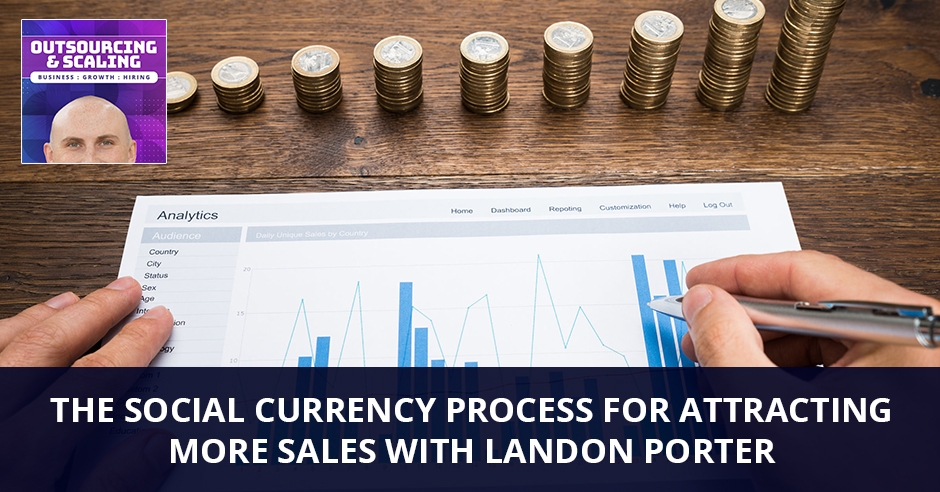


—
Listen to the podcast here:
[smart_track_player url=”https://www.podetize.com/statsapi/www.podetize.com/wp-content/uploads/fileuploads/11-5b145ef137b51b3d1af0633e9305c43d/06/2019/d1e5c0497446e635b0fdf54f27cfea07.mp3″ title=”The Social Currency Process For Attracting More Sales with Landon Porter” artist=”Nathan Hirsch” image=”https://freeup.net/wp-content/uploads/2019/04/OAS.png” ]
Download the audio file here.
The Social Currency Process For Attracting More Sales with Landon Porter
We have a special guest, Landon Porter. Landon, how are you?
I’m fantastic. How about you?
I’m doing great. Landon is the Head Gorilla at Gorilla Marketing, a different type of sales and marketing. I’m excited to talk to him about tactics that he uses for him and his clients. Before you were an entrepreneur, what type of kid were you growing up? Were you a rebel? Were you a straight-A student? Some part of me doesn’t see you in a military academy.
I was one of the rebel kids. It’s BMX, skateboards, dirt bikes, heavy metal, heavy metal T-shirts and long hair. I did get decent grades. I wasn’t a straight-A student though. I was a hell-raiser for sure.
I was in a similar boat. I didn’t get bad grades. I didn’t get great grades. I rebelled whenever I could. Did you know you wanted to be an entrepreneur?
When I was going through high school, my counselor came to me in tenth grade and said, “You can get good grades but you don’t want to be here. What do you want to do?” I said, “I like cars and I love food.” My counselor in tenth grade helped me figure out that I should become a chef. I graduated high school a year early because I was in a restaurant arts program through a trade school. I ended up doing an apprenticeship at one of the nicest two hotels in Colorado. I became a chef. I was in the food industry for many years. It’s nights, weekends, holidays and two little kids. I went from there to sales.
What was that transition like? How do you go from chef to sales?
My dad, for a long time, was a car sales guy. His best friend was still in car sales when I was looking for something else to do. I took the summer off and I went and worked with him. He did wholesale. He didn’t work in a dealership or anything like that. He placed mid-end to high-end sports cars with specific people. He would go hunt down a car that somebody wanted. I spent the summer working with him. From there, I met somebody who worked in the mortgage industry and wanted somebody to cold-call homeowners at night to get them to refi. I took him up on that. I spent a few years in real estate as a whole. I went into corporate finance, asset management protection.
Let’s talk about cold-calling. It takes a special person who calls them out of the blue to be able to close a sale. What was that like? What did you learn from that?
I am not an extrovert by nature. I’m not a super shy introvert, but I’d rather not have people if I don’t have to. The first couple of weeks that I did the cold-calling, I didn’t want to do it. I avoided the phone. It was weird and awkward, but I figured it out. I got good at sales. I learned all of the tactics and techniques to make people make decisions. I’m sure we’ll get into how that’s changed. It sucked, the cold-calling side.
How old were you? Put that in perspective.
I was 24 when I started cold-calling.
We’re at a point in time in humanity where most of us don’t want to be sold. We all want to buy the right stuff.
How long did you do that?
I was in sales for fifteen years. From there to almost 39, I was in sales. Cold-calling was a part of the whole thing. When I was in the real estate niche, the first six or eight months I did a lot of cold-calling and then I started building relationships and I built a referral business. The market crash was coming and we could all see it, so I got into corporate finance globally. They had a requirement of 300 phone calls a day. It sucked.
It sounds brutal. Did you work for other people until you were 38-ish?
Yeah. A few years ago I said, “I’m done with this. I’m going to do my own thing.” I got out of sales completely. My wife and I went and created a community and an audience around helping parents deal with raising pre-teens. About a year into that, a handful of people were like, “You’ve got to teach this,” relating to the sales thing. I was like, “I’m done with that.” Here I am a few years later, doing that exactly. I’m teaching people how to do the sales thing.
Walk me through your first year as an entrepreneur. I’m assuming it’s not easy saying, “I’m 38 going on 40. I’ve worked for someone else my entire life. I’m going to do my own thing.” What was that like?
It was interesting what spurted on. Let’s go back to when I was about 35. I legitimately started trying to figure out a business thing that I could do while having a full-time job. I looked into subscription boxes and a couple of different things. We were getting ready for my son to go into high school. We were sitting in the auditorium listening to the mayor of our city speak to the auditorium of parents and students. I’m looking at this guy. He looks old. He’s got the bald head with the hair on the sides, the glasses and the old dude suit. It turns out he graduated the year I did. I’m sitting in the audience wearing jeans and a hoodie, with a crazy beard. I was like, “That dude’s a mayor.”

That night, some of the things they were talking about, how the school is changing and how they’re allowing kids to identify what they want to do with their career path caught something in my head. My kids think that I don’t understand them. I’ve been talking to all these other parents who have that issue. We ran with the idea of, “What if we could help kids figure out what it is they were interested in, as a layer on top of where some of the schools around the nation are going?” It took off. I quit my day job. We focused solely on that, built an audience and started building courses and coaching.
It’s still on the back burner because it’s viable, but that first year of business ownership, I’m an adult. I’m not twenty years old with not a whole lot of money. I had money in the bank that I could lean on. I thought it out. We took a lot of time to play with what does and doesn’t work as far as being a business owner. Not that it was super easy, but it’s a lot easier than it seems. It’s like a lot of people have it. You jump out of your day job and have 30 days until you have to pay rent again. Business ownership is a roller coaster.
Let’s talk about your sales mentality. You came from car sales, even though it was a little different type of car sales. You went into mortgages and a lot of corporate stuff. I’m assuming your strategy now is way different than that. How has that evolved? What pieces did you take from that to come up with your strategy?
All of the dirty tactics, tricks and psychological warfare that are prevalent in sales now, I learned how to do all of that stuff well. If you got on the phone and you needed the thing that we sold, you’d be my client. That’s the way it goes. About halfway through my sales career, it was a hard couple of months. It started with one morning. It was about 4:30 in the morning. I’m staring at myself in the mirror, getting ready to go to work. I’m like, “I hate you.” It was because I had all these clients that I had to work with day-in, day-out, week-in, week-out and I couldn’t stand most of them. It was right at the time my kids were going from little kid to preteen and that relationship dynamic changes.
At first, what the problem was it didn’t hit me, but I knew that I was miserable. It had gotten to the point where I hated Sundays because the next day was Monday. I didn’t want to go to work because I hated dealing with my clients. What eventually occurred to me was that I was so good at bringing people on as a client, but I had to deal with them after the fact. It was having to deal with people that I couldn’t stand that made it miserable. I rearranged how I went about vetting prospects who could be my client. It completely changed the way that I do it. Through that process, I developed a very specific and very different way to prospect and onboard a client through a sales conversation that is nothing like the way traditional sales is made.
It so happens that we’re at a point in time in humanity where most of us don’t want to be sold. We all want to buy stuff that’s the right stuff. We all want to buy from people where we’re like, “This guy’s awesome.” We as a species have gotten good at being able to manufacture that relatability, which causes that know, like and trust and then we end up in relationships that are no bueno. Apparently, this message the way that I make sales resonated. It’s all based on relationships. We’re in the relationship economy. It’s all based on full transparency, be exactly who you are like, “I don’t care who you are, just be that so I can judge that and make a decision if I like that or not.” It’s a completely different process.
Setting boundaries and managing expectations are the keys to onboarding a client.
Let’s talk about your process. You take someone that doesn’t know sales. They master sales and they can sell to anyone. How do you get to that point where you’re only selling to the people that you want to work with?
It’s all about identifying what you do and don’t want, what you will and won’t tolerate as far as a client that you onboard. This changes the process fundamentally instead of you going for the yes or going for the no, which almost everybody does. This removes that responsibility from your prospect and puts it on you. You get to say yes or no. It starts with identifying who it is that you want to work with and why. It’s not, “They’ve got enough money or they want or need it.” Those are all superficial stuff. It’s all about identifying what it is that you want from a client. You’ve got to identify who it is that you want to work with. The way that I look at sales and marketing is very similar to dating. If you made eye contact with somebody in line at Starbucks, you smiled at each other, you went over and started talking and you were like, “I don’t like this person,” you’re probably not going to continue going down that road of trying to date them.
A lot of us end up doing that in our businesses and it’s not always so glaring, but if we’re paying attention and we’re focused on the people that we’re talking to, it’s pretty easy to see those red flags come up. This is the process. It’s identifying who it is that you want to work with based on a values level, “Do I relate to this person or not?” Then it comes down to, “Do they want it and need it? Are they interested in starting now? Do they have the resources to do so? Am I the right solution for them?” If you can answer all of those questions, it’s easy to have a sales conversation. A lot of people think they need a script to be able to do that and that’s not the case. There’s a simple process to a sales conversation. It’s the introduction, setting the agenda, qualifying and making the offer.
It’s in this setting the agenda and the qualifying part where we identify if we are the right fit for them, if they’re ready to get started, if they’ve got the resources, if they want and need the thing and if we would love to work with that person. If all of those things are a fit, it’s like, “Bob, this is the right thing for you. Here you go. Do you want it or not?” It’s simple to the extent that people go, “It’s got to be more complicated than that.” It’s funny when people finally get this in our world. They’re like, “This is so easy.” They’re dealing with people that are easy to talk to. They’re dealing with people that want and need the thing. They’re the right fit for their prospects. It makes the whole process easy.
I’m assuming setting expectations is also a part of that. We’re like, “I don’t work weekends.” That’s a basic one but it’s whatever your expectations are. “This is how I work with my clients. This is the relationship I want to have. I don’t work with people that don’t respect that relationship.” Is that a part of it?
That’s a part of the qualifying process. In a sales conversation, our job is to identify if they want it and need it. We’ve got to diagnose it. In that part where we’re figuring out if this is the right person for us, it’s all in the qualifying. “If you’re going to be leaning over my shoulder, yelling at me every 35 minutes and calling me on Sunday mornings at 6:00, this isn’t going to work.” Setting boundaries and managing expectations are the keys to onboarding a client. You’ve got to go through all that stuff and make sure they’re the right fit for you.

Let’s say someone’s bought into this. They’re like, “This is resonating with me. I need to do a better job making sure that I only work with people that I want to work with.” They change their mentality and they start going down this path. Where do you see most people mess up once they start to change that mentality?
The biggest thing is a lot of people are afraid to reach out and initiate a conversation. It’s because we’re all taught and/or we assume that we should reach out and start a conversation and say, “Here are nine paragraphs of this awesome thing that I’ve gotten. You should buy it because I think it’s the right thing for you.” It’s all based on relationships. If you go through any real sales training where they’re selling anything more than a couple of $100, they talk about humans, in general, needs seven to twelve touch points before they’re ready and willing to buy. How do we accomplish that when we’ve got social media and we’re all sitting behind computers? That’s called social currency, light touches. The agenda of the thing that I want to sell has not come up yet. We’re trying to identify if we are a fit relationship-wise, relatability-wise.
Once they start getting this and they go, “This makes so much sense,” and they’ve got a couple of conversations that happen, they go, “I’m going to find people that I can talk to because this process works.” They start getting rejections. Even though some of those people are the right fit, it’s too early. At Starbucks, you don’t make eye contact and go over and stick your tongue in her ear. That’s what it feels like a lot of us do on social media. Once they figured that out, they go, “This isn’t a 30-second pitch in somebody’s DMs. This is seven to twelve touch points over the course of five to ten business days.” When done right, those people reach out to you and say, “I saw that thing that you do, that thing that you posted. Can we talk about that? I need that,” and then it takes off.
Give us an example of some of those touch points. Let’s say that there’s an influencer and you want to work with them. You don’t want to reach out and be like, “Buy my product.” Where do you even begin? You’re right, that’s where a lot of people get lost.
I call it social currency. The way that I do this is if I identify somebody that’s the right fit. Let’s say that they’re on Facebook. I’m going to send them a friend request on Facebook. I’m going to like something on their wall. If they accept that friend request, I’m not going to send them a message. In a day or two, I’m going to go back to their profile. I’m going to find something else that I dig, something that in real life, outside of my business, I appreciate. Whether it’s a band, a car or a picture of a dog, I’m going to like or heart it. I’m going to do the same thing in another day or two. A day or two after that, I’m going to come back. I’m going to find something else that I dig. Maybe they wrote an article or they did a post that I dig and agree with. I’m going to short comment on that. I’m going to, in an agreeing way, comment, “I totally agree or yeah,” or whatever. I’m starting to build a little bit of presence. They’re becoming aware of me paying attention to them, which is what all of us want.
In LinkedIn, it’s the same way. If you find somebody on LinkedIn and they’re active on LinkedIn or they’ve got a well-thought-out and well-planned out LinkedIn profile, it’s the same process. You show up in their world half-a-dozen times over the course of five to ten business days. You’re going to like a post or a comment, to short commenting and to starting a conversation with them about something. If you’re not willing to do that, maybe you don’t deserve the business. This is what it means to be in the relationship economy. This is not, “Can I build a list of 10,000 people and blast them email messages to buy my crap?” This is, “Build a list of 20 or 30 people that could be the right client for you and go and engage with them.”
Humans need seven to twelve touch points before they’re ready and willing to buy.
Let’s talk about rejection. Rejection is always a part of sales. It’s the thing that turns people off. If you go back to your dating analogy, if someone gets rejected by 25 girls, at some point, they’re going to be scared to talk to another girl, even if they’re using a different approach. What’s your mind to that rejection? Mine is unless someone tells me like, “Don’t ever contact me again,” I’m going to go after them again. I might tweak my process. I got a podcast where it took me a few years to get on that podcast. I’m not giving up. I don’t get aggressive. I don’t get upset. None of that happened. It’s, “I think we should work together or let’s connect.” You know that because I bothered you a lot before we talked. What is your mindset on rejection? Does that mean you’re not doing it right? Is it to just persevere?
My mindset on that is your actual agenda in the wrong place. You’re thinking more about what you want than more about what they want. The way to fix that is if you remove the focus on you. This fixes the sales conversation itself. It removes all of the weirdness, the awkwardness, the nervousness and the butterflies. Stop focusing on you, what you’ve got and what you want. Focus on them. If you do the qualification process right, there’s no rejection. This removes their responsibility to tell you yes or to tell you no. It puts that responsibility on you. If you qualify somebody, they’re the right fit and work on the same page, it’s the thing for them and you’ve qualified correctly. It’s when you say, “Bob, it’s the right fit. This is it. Here you go. You can have it if you’d like.” I’m telling Bob yes or, “I don’t think this is the right fit for you, Bob. This isn’t whatever, or we’re not a fit. The way you talk to people, I’m never going to deal with that.” I’m telling him no. Done this way and done the right way, there is no rejection.
Do you have conversations with people where it’s the right fit, they’re 100% qualified, they want and need it, you are the right solution, you say, “Here you go, Bob,” and they don’t take you up on it? That’s their issue. This is called positive indifference. “Here’s the solution that you’re looking for. It checks all the boxes. Based on what we discussed, you and I are the right fit. I’m the only solution for you in this marketplace. You can have it if you’d like it. Here you go.” Bob doesn’t take me up on it. It’s not my job to take them, shake them and make them understand like we were taught several years ago. That doesn’t fly anymore. That, in my mind, is not rejection.
It makes a ton of sense. Back in the day, if you went back years ago, I was a super aggressive salesperson. I’ve changed where you give that value upfront. One of the things that I sometimes struggle with is I don’t know what that person needs until I talk to them. I can’t figure that out until I get on the phone with them. Are you figuring that out during the touch points? How do you figure out some stranger and what you can do to help them, even if you have a lot to offer?
In that process that I called social currency and that’s a process that I teach. When our clients do this and they do it the right way, what they find are, more often than not, the people that they’re engaging with reach out to them and initiate that conversation. It’s not a, “I need to go start a conversation but they’re not responding to me.” That’s already happened. You do still, in some cases, need to initiate the conversation. Like there’s a process for the sales conversation and for social currency, there is a process to initiate a conversation. It’s getting somebody to raise their hand and prequalifying them to make sure that you want to get on a call with them. The call to action or making them that offer is, “Would it make sense for us to have a ten or fifteen-minute phone call?” “Would it make sense for us to hop on Zoom really quick?” “This makes sense. I think we should get on a phone call. What do you think?” That solves that.
Where do you see this relationship currency going? Has it changed over the years that you’ve been doing it? Is it staged the same? Things around it have changed, marketing and social media.
We’re all familiar with the funnel thing, Russell Brunson and that whole idea. It’s our ability to market, niche down, get more specific and create our own blue oceans and the way that I see that is we do it based on our personality. There are a lot of people that have sales training, but there aren’t very many people out there that have the personality that I’ve got. There’s a certain crowd of people that resonate with my personality. That whole process, the relationship economy, is nothing more than a further segmentation of what’s already out there. When Ford started making cars in his twenties or his teens, there were only a couple of car manufacturers around the world. Now there are hundreds. It’s no different. Everything that anybody that’s reading this blog sells. There are other people, hopefully, fingers crossed, who are selling the same thing, whether it’s a product or a service. How do you get them to go, “I want blue instead of red?” It’s this process. It’s the relationship economy. It’s all based on personality.
Landon, I appreciate you coming on. I learned a lot. Our readers learned a lot. Where can people find out more about you?
Go to TheSalesGorilla.com/bonus. We’ve put together a workbook for you to get started on this.
I appreciate the time. Have a good rest of the day.
Important Links:
- Gorilla Marketing
- TheSalesGorilla.com/bonus
About Landon Porter
 As the “Head Gorilla” at Gorilla Marketing, Landon helps business owners like yourself attract clients by packing up everything you’ve been told about sales and throwing it out the window. There’s no sales script, no selling your soul for a check, and a whole lot of you being rewarded for being your weird ass self.
As the “Head Gorilla” at Gorilla Marketing, Landon helps business owners like yourself attract clients by packing up everything you’ve been told about sales and throwing it out the window. There’s no sales script, no selling your soul for a check, and a whole lot of you being rewarded for being your weird ass self.
Instead of chasing a “yes” from your prospects you’re “getting to the no” as quickly as possible. Instead of conforming to the things you learned from your old corporate positions, you’re given permission to find out how you naturally open relationships with clients so you can shine authentically.
And to top it off, all those clients you attract from this? They’re not just any clients. They’re perfect-for-you clients that not only need what you have to offer and are willing to pay the price but fit the mold of who you are. So you’re doing the work you love, with people you love, and getting paid what you’re worthwhile you’re at it. This is what life is like in the relationship economy, and Landon is here to show you how to tap into it.
